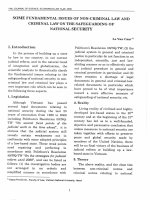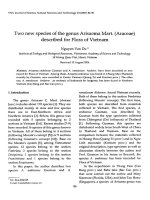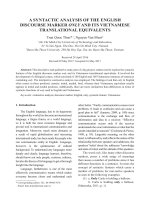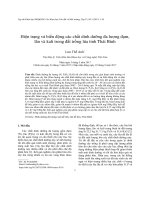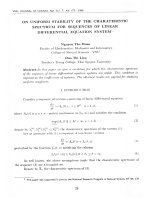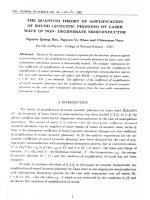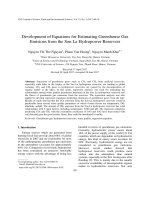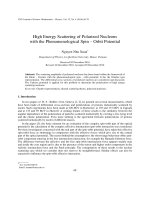DSpace at VNU: The 6th meeting of the asian consortium for the conservation and sustainable use of microbial resources (ACM)
Bạn đang xem bản rút gọn của tài liệu. Xem và tải ngay bản đầy đủ của tài liệu tại đây (1.03 MB, 108 trang )
bìa trong
1
2
Dear Participants,
The exploiting of microbial resource is one of the most concerned problems in the fields
of medicine, biotechnology, agriculture, pharmacology… all over the world. Asia has
been shown to possess extremely abundant and diverse microorganisms, therefore the
exchanging and discussing not only scientific problems and ideas but also generally
developmental strategies at the common forum for the Asian scientists would be
valuable. Continuing the annual meeting of Asian Consortium of Microbiology (ACM),
this time we are delighted to organize the 6th ACM which will be held on November 27th,
2009 at Hanoi - Vietnam in order to promote collaboration among government or public
organizations in Asian countries for the purposes of enhancing conservation and
sustainable use of microbial resources in Asia.
In the proceeding of the 6th ACM the country reports and the keynote lectures as well as
some selected scientific articles are present. Through the country reports of Vietnam,
Thailand, China, Korea, Malaysia and Philippine the activities in bio-diversity
conservation, material transfer agreement (MTA) and human resources development will
be reviewed. Also, four keynote lectures of the invited professors from Japan, Belgium
and Vietnam will present specialized topics in the biotechnology field. In addition, the
short communications, mainly of Vietnamese scientists, will show some of the various
aspects to study the bio-diversities and the characteristics of microorganisms.
Director
Dr. Duong Van Hop
Institute of Microbiology and Biotechnology,
Vietnam National University, Hanoi.
3
9
CONTENTS
Progam of the 6th ACM Meeting
Abstracts of Country Reports
1
Keynote Lectures
19
Short Communications of The Host Country
25
List of Participants
96
Information of Meeting Hall and Hotels
99
2
Progam of the 6th ACM Meeting
Meeting Program
November 26th, 2009
Arrival of the participants
Moevenpick Hotel, 83A Ly Thuong Kiet, Hanoi
November 27th, 2009 Conference room 1, 2 - Moevenpick Hotel
08:30 – 09:00 Registration
09:00 09:30 - Opening Ceremony
Dr. Duong Van Hop, the director of IMBT
- Adoption of 5th ACM Minute of Meeting (Korea)
Morning section
Chair persons: Dr. Duong Van Hop (Vietnam)
Dr. Jung-Sook Lee (Korea)
09:30 – 10:10 Keynote lecture
Genomic approach to seasonal and pandemic influenza viruses
Prof. Nobuyuki Fujita
National Institute of Technology and Evaluation (NITE), Japan.
Reports from ACM country members (1st part)
10:10 10:25 - Cambodia
10:25 10:40 - China
10:40 – 10:55 - Indonesia
10:55
11:15
Coffee break
11:15
11:55
Keynote lecture
From the cells to the end product. The case of lactic starter production
Prof. Phillip Thornart
University of Liege, Belgium
Lunch
12:00 – 13:30
Chair persons: Dr. Sukor Nordin (Malaysia)
Dr. Juncai Dong (China)
Reports from ACM country members (2nd part)
- Japan
- Korea
- Malaysia
Afternoon section
13:30 13:45
13:45 – 14:00
14:00 – 14:15
14:15 – 14:55
1
Keynote lecture
Deciphering On-Off signaling network of Streptomyces secondary
metabolism
Prof. Takuya Nihira
International Center for Biotechnology, Osaka University, Japan
14:55 – 15:10
15:10 – 15:50
15:50 – 16:05
16:05 – 16:20
16:20 – 16:35
18:00 – 21:00
Coffee break
Keynote lecture
Yeast biodiversity and application in biotechnology – Research at FIRI
Vietnam
Dr. Vu Nguyen Thanh
Food Industrial Research Institute (FIRI) - Vietnam
Reports from ACM country members (3rd part)
- The Philippines
- Thailand
- Vietnam
Dinner, Sen Resaurant, West Lake - Hanoi
Novotel Halong Bay
November 28th, 2009
08:00 – 12:00 Travel to Halong
12:00 – 14:00 - Check-in at Novotel Halong Bay
- Lunch
Scientific disscusion
Yen Tu Conference room
Chair persons: Dr. Suzuki Ken-Ichiro (Japan)
Dr. Tanit Changthavorn (Thailand)
14:00 – 16:30 Report on Task Force:
- Biological Information Management (BIM)
- Human Resource Development (HRD)
- Management of Material Transfer (MMT)
General Discussion
Conclusion
Announcement of 7th and 8th ACM meeting
Closing Address
18:00 – 21:00 Dinner, The Square Restaurant, Hovotel Halong Bay
November 29th, 2009
08:00 – 08:30 Hotel check-out
09:00 – 15:00 Boat tour in Halong Bay
15:00 – 19:00 Travel back to Hanoi
November 30th, 2009
Departure of the participants
2
3
Abstracts of Country
Reports
9
Yuguang Zhou, 6th ACM meeting – Hanoi 2009
Country Report from China
Yuguang Zhou*
Institute of Microbiology, Chinese Academy of Sciences,
NO.1 West Beichen Road, Chaoyang District, Beijing 100101, China
ABSTRACT
Biological resource centers (BRCs) are an essential part of the infrastructure dedicated to the
investigation of the structure, functions, and applications of biological systems by developing
cooperative activities for sharing validated biological material and data among government
agencies, industry, academia, and the public. Some attempts have been made since 1980’s for
improving culture collection management in China including establishment of CCCCM,
CTCCCAS and NFSNR.
China General Microbiological Culture Collection Center (CGMCC), founded in 1952, is
affiliated with the Institute of Microbiology of the Chinese Academy of Sciences (IMCAS),
which is a leading microbiological research institution in China. The CGMCC became a member
of the CCCCM, CTCCCAS and World Federation for Culture Collections (WFCC) in the early
80’s or 90’s and acquired the status of an International Depositary Authority (IDA) under the
Budapest Treaty.
Biological Resources Center, Institute of Microbiology Chinese Academy of Sciences (IMCASBRC) has been set up by integrating the China General Culture Collection Center (CGMCC), the
Information Center and the newly developed high throughput evaluation platform of microbial
metabolites in July, 2009. The mission of IMCAS-BRC is to serve as an integrated public
infrastructure of culture collection, research and utilization of microorganisms, in order to
sustain biotechnology innovation. IMCAS-BRC not only provides universities, institutions, and
*
Corresponding author. Tel.: 86-10-64807355
E-mail:
10
Yuguang Zhou, 6th ACM meeting – Hanoi 2009
industries of microbial strains, metabolites and gene resources and services, but also welcomes
joint research and development projects.
IMCAS-BRC has established collaboration with many culture collection centers worldwide. It is
in the process of establishing its standards on resource management and quality assurance
systems in accordance of OECD’s standard for BRC.
11
Jung-Sook Lee, 6th ACM meeting – Hanoi 2009
Country Report from Korea:
Current Status and Future Plan of KCTC/BRC
Jung-Sook Lee*
Korean Collection for Type Cultures (KCTC), Biological Resource Center (BRC),
Korea Research Institute of Bioscience and Biotechnology (KRIBB),
111 Gwahangno, Yusong-gu, Daejeon 305-806, Korea
ABSTRACT
The largest and oldest culture collection in Korea, Korean Collection for Type Cultures (KCTC)
has three functions as follows. 1) We carry out the collection and preservation of core biological
resources from home and abroad, offering public support by distributing biological resources to
academia, industry, and research institutions, and organizing patent strain deposit. Especially, we
were designated as an International Depositary Authority (IDA) under Budapest Treaty by
World Intellectual Property Organization (WIPO). Now we can manage about 17 kinds of
biological resources including bacteria, yeast, fungi, algae, animal and plant viruses, embryos,
animal and plant cell cultures, seeds, RNA and etc. We manage about 18,000 biological
resources including patent strains. Every year over 1,500 strains are newly added to KCTC. We
also distribute more than 5,000 strains every year to home and abroad. 2) We develop the
platform technology for the screening, identification and preservation of useful biological
resources. We publish more than 40 papers concerning biological resources. Since 1997, we
reported more than 150 new species. Last year, KCTC was cited by over 160 papers in PubMed
search. 3) We are trying to construct on local and international network for biological resources
and related information, and support workshops, conferences, and consultation, etc.
As a national bio-infrastructure for biological resources, we perform the role of a biotechnology
think-tank in the field of bio R&D. At present, we have many small collections for
*
Corresponding author. Tel.: +82-42-860-4677
E-mail:
12
Jung-Sook Lee, 6th ACM meeting – Hanoi 2009
microorganisms in universities in Korea. KCTC plays an important part in networking among
the collections in domestic, and participates actively in international network among the
collections in the world. We concentrate our efforts to increase KCTC to international biological
resource center.
13
Tan Geok Hun, 6th ACM meeting – Hanoi 2009
Country Report from Malaysia:
Research Update on Conservation and Utilization of
Microorganisms
Tan Geok Hun *
Strategic Resource Research Centre, Malaysian Agricultural Research and Development
Institute (MARDI), P.O. Box 12301, General Post Office, 50774 Kuala Lumpur, Malaysia
Microbial Utilization
Microorganisms are a vital component of the world’s biodiversity worldwide. They stand out as
the major building blocks for biotechnology related industries. However, the role of microbial
genetic resources in bioindustries, especially in Malaysia is as yet not fully acknowledged and
needs to be nurtured. There remains an urgent need for information and better understanding of
our microbial diversity for increased investment in microbial resources by both local and
international entrepreneurs. Harnessing microbial diversity will provide solutions to many
problems in agriculture, forestry, the environment, healthcare and food and make available
valuable resources for the development of bioindustries. However, microbes also exist as
pathogenic forms, contributing to loses in production and quality of agricultural produce, post
harvest loses and contamination of animal feed and food spoilage.
Based on the World Data Center for Microorganism (WDCM Statistic, update 2009), about
2,508 culture strains of microorganism have been registered with the center involving five
institutions and research agencies. From Malaysia, MARDI is one of the research agency
registered with the WDCM with acronym of FTCC (Food Technology Culture Collection) and
the number of microbes registered was 349 strains. Some of these strains have been used for the
*
Corresponding author. Tel.: 03-89437439
E-mail:
14
Tan Geok Hun, 6th ACM meeting – Hanoi 2009
production of fermented foods, such as “tempeh”, “tapai”, unclarified fish sauce (budu),
fermented Tilapia (Pekasam Tilapia), fruits yoghurt and soy source.
The others are Universiti Kebangsaan Malaysia [UKKP (402 strains) and SKUK (381 strains)],
University Malaya [DBUM; IPT (1300 strains)] and Universiti Putra Malaysia (UPMR (76
strains) have registered with the WDCM. The Forest Research Institute of Malaysia (FRIM) in
collaboration with Nimura is also actively involved in the running of microbial collection center
at the national level. At present, over 2495 species of microbial fauna have been successfully
identified and characterized, consisting of: (i) 300 algae, (ii) 1148 bacteria, (iii) 273 fungi, (iv)
269 yeasts, and (v) 505 viruses (Krishnapillay, 2004).
More microbial resource collections have to be established to adequately carry out conservation
function. Malaysia is particularly rich in biodiversity having a wide range of ecosystems waiting
to be explored. However, currently Malaysia does not have national Microbial Resource
Collection Center (MRCC). It is felt that MARDI can play a major and important role within a
network of Malaysian collections and ultimately links can be established with international
organizations and collections.
Development and enhancement of sustainable utilization of microbes in Malaysian agriculture is
still new (Table 1).
Table 1. Potential contribution of microbial diversity in Malaysia
No
1.
Functional
Groups
Fungi
Targeted industries
Microbial Utilization in Malaysia
Agriculture
(biofertilizers,
biopesticides), food, animal
feed
and
other
biotechnological industries
Mycorrhiza
as
plant
growth
enhancers (Ghazali et al., 2005; Lee,
2006).
Trichoderma spp as biocontrol agents
for plant diseases (Jinantana and
Sariah, 1998, Phua et al., 2005;
Begum et al. 2008).
Exserohillum
longirostratum
as
bioherbicides against planytation
weeds (Noor Hasniza et al., 2005).
Aspergillus, Trichoderma for PKC
and silage as animal feed (Zaiton, et
al. 2008).
Edible Mushrooms (Ganesan, 2006).
15
Tan Geok Hun, 6th ACM meeting – Hanoi 2009
2.
Bacteria
Agriculture
(biofertilizers,
biopesticides),
bioremediation, food (biofermentation (probiotics), and
other
biotechnological
industries (e.g.
3.
Virus/
bacteriophage
Agriculture
(biofertilizers, Bioagents against oil palm pests,
biopesticides)
and
other tomato, potatao (Tan et al., 2008).
biotechnological industries.
Azospirillum
brasilenses
and
Rhizobium as Nitrogen fixers
(Shamsuddin
et
al.,
1992;
Shamsuddin et al.,2003; Saad et al.,
1999; Amir et al. 2003; Radziah and
Farzana, 2006).
Phosphate solubilizing bacteria for
nutrient recycling (Mia et al., 2001;
Radziah and Lizawati, 2005; Phua et
al., 2005).
Bacillus thurigensis, Burkholderia
sp, as bioagents (Sivapragasam et al.,
1996; Phua et al., 2005).
Lactobacillus plantarum in health
drinks
Yeasts and lactic acid bacteria in food
fermentation such as tempeh, tapai
and soy source (Ng et al. 2005; Lim
et al., 2005)
Source
of
transgenes
(Agrobacterium)
Human Resource Development
In the last few years, there has been dramatic increase in the number of new Microbiologists
recruited by Mardi, bringing to the total number of 40 the current number of research officers
(RO) conducting microbiology research works in MARDI. As measures in the capacity building
effort, some workshops and seminars on the identification, characterization, biosafety and
conservation have been organized all over the country, such as Workshop on Bacterial Isolation,
Identification and Preservation in February 2009 (Universiti Putra Malaysia);
Biosafety
Containment Principles (BSL-3) workshop and seminar in May 2009 (Universiti Malaya);
Seminar on The 3rd Regional Conference on Natural Resources in the Tropics in August 2009
(Universiti Malaysia Sarawak); The 8th Malaysia Genetics Congress in August 2009 (Universiti
Kebangsaan Malaysia); Seminar on Biosafety in the Microbiology Laboratory in September
2009 (Universiti Malaya); The Application of Polymerase Chain Reaction based Technique in
16
Tan Geok Hun, 6th ACM meeting – Hanoi 2009
Biotechnology Workshop in October 2009 (Universiti Malaysia Sabah) and Molecular
Phylogenetic Workshop in October 2009 (Universiti Malaysia Sarawak). This year, the
Malaysian Society for Microbiology will held an International Congress of Microbiology in
December, Penang which will provide a platform for discussion, exchange of idea, and sharing
of information on the latest information and technology among microbiologists in Malaysia and
worldwide.
Biological Information Management
Currently MARDI is developing an information system called AgrobIS to provide the public
direct access to data of all biological genetic resources conserved at MARDI. This system once
fully operating will contain more than 2,500 of microbial genetic resources, more than 40,000
accessions of plant genetic resources for food and agriculture (PGRFA) which includes fruits,
rice, vegetables, and medicinal plants, and about 30,000 specimens of arthropods.
MARDI is in the initial stage of proposing the establishment a national Microbial Resource
Collection Center (MRCC), and Malaysia also planning to become a member of Budapest Treaty
on the International Recognition of the Deposit of Microorganisms for the Purposes of Patent
Procedure. A few meeting have been carried out to discuss the matter for joining the treaty. It is
hope that the establishment of MRCC in MARDI/ Malaysia will bring together microbiologists
and research related to microorganism, microbial processes and products under one umbrella and
provide a single platform for focused planning and implementation of research and development
activities in microbiology, as well as optimum utilization of resources and available research
support.
Conclusion
In brief, the current scenario in MARDI with respect to research and development in
microbiology lends itself to new thrusts and directions that can substantially increase the
Institute’s contribution in microbial research and services to national development in the context
of an increasingly globalized world.
References
17
Tan Geok Hun, 6th ACM meeting – Hanoi 2009
Amir, H.G., Shamsuddin, Z.H., Halimi,M.S., Ramlan, M.F. and Marziah, M. 2003. N2 fixation
plant growth enhancement and root-surface colonization by rhizobacteria in association
with oil palm plantlets under in vitro conditions. Malays. J. Soil Sci.6 (1):75-82.
Begum, M.M., Sariah, M., Adam, A.P. and Zainal Abidin, M. A. 2008. Antagonistic potential of
selected
fungal and bacterial biocontrol agents against Colletotrichum truncatum of
soybean seeds. Pertanika J of Tropical Agric. 31:85-93.
Ganesan, K. 2006. Edible Mushroom. Proceeding of the National Conference on
Agrobiodiversity, Conservation and Sustainable Utilization 2006, Kuching, Sarawak.
Jinanatana, J. and Sariah, M. 1998. Potential for biological control of Sclerotium foot rot of
chilli by Trichoderma spp. Pertanika J. Trop. Sci. 21: 1-10.
Lim Y.S., Foo H.L., Raha, A.R., loh T.C. and Gulam rusul R.A. 2005. In vitro assessment of the
probiotic characteristics of Lactobacillus plantarum I-UL4. Proceedings of the 27th
Symposium of the Malaysian Society for Microbiology, 24-27 November 2005. Pp 357359.
Ng K.Y., Foo H.L., Rosfarizan M., Loh T.C., Raha A.R.,Lim Y.S., and Gulam Rusul, R.A.
2005. Media optimization of bacteriocin production by Lactobacillus plantarum I-UL4.
Proceedings of the 27th Symposium of the Malaysian Society for Microbiology, 24-27
November 2005. Pp 354-356.
Radziah, O. and Farzana, Y. 2006. Root colonization of sweetpotato by plant growth-promoting
Rhizobacteria.
Proc. Malaysian Society of Soil
Science Conference 2006, Kuantan,
Pahang, pp. 200-2003.
Saad, M.S., Ali Sabuddin, A.S Yunus A.G. and Shamsuddin, Z.H 1999. Effects of Azospirillum
inoculation on sweet potato grown on sandy tin-tailing soil. Commu. Soil Sci. Plant Anal.,
30(11&12): 1583-1592.
Shamsuddin, Z.H., Puteh, A. and Saud, H.M. 2003. Application of vegetable soybean as an
intercrop with paddy. Research Product Exhibition. Universiti Putra Malaysia.
Shamsuddin, Z.H., Kasran, R., Edwards, D.G. and Blamey, F.P.C. 1992. Effects of calcium and
aluminium on nodulation, nitrogen fixation and growth of groundnut in solution culture.
Plant Soil 144, 273-279.
18
Tan Geok Hun, 6th ACM meeting – Hanoi 2009
G.H. Tan, M.S. Nordin and A.B. Napsiah 2008. Isolation and Characterization of Lytic
Bacteriophages from Sewage Water. Journal of Tropical Agriculture and Food Science 36:
287-291.
Zaiton, S., M. Sariah, M. and M. A. Zainal Abidin. 2008. Effect of endophytic bacteria on
growth and suppression of Ganoderma infection in oil palm. Inter. J. Agriculture and
Biology . 10:127-132.
Acknowledgement
The author wishes to thank the Director General of MARDI for the permission given to the
author to participate in this important meeting and presenting the country report. The author
would also like to thank the organizers of “The 6th Meeting of the Asian Consortium for the
Conservation and Sustainable Use of Microbial Resources (ACM)”, Institute of Microbiology
and Biotechnology (IMBT) and Vietnam National University Hanoi (VNUH) for providing this
opportunity to participate in this expert meeting. The author would also like to thank Dr. Mohd.
Shukor Nordin, Deputy Director of Strategic Resource Research Center for his assistance in
editing this report and also Dr. Mohd Yusoff Abdullah for his guideline and support.
19
Rosario G Monsalud, 6th ACM meeting – Hanoi 2009
Country Report from Philippines:
Updates on Biological Information Management and Human
Resource Development in the Philippines
Rosario G. Monsalud*
Philippine National Collection of Microorganisms (PNCM), National Institute of Molecular
Biology & Biotechnology, University of the Philippines Los Baños, College,
Laguna 4031 Philippines
ABSTRACT
Culture holdings of the affiliate culture collections of the Philippine Network of Microbial
Culture Collections (PNMCC) slightly increased to 7,796 accessions from the 7,484 accessions
reported in 2008. This is with the addition of the collection of the De La Salle University in
Manila. The Museum of Natural History (MNH) and the Philippine National Collection of
Microorganisms PNCM) had a slight increase in culture holdings but the United Laboratories
(UNILAB) collection has decreased from 2046 to now only 1552. The Industrial Technology
Development Institute (ITDI), Ecosystems Research and Development Bureau (ERDB),
University of the Philippines Culture Collection (UPCC) and University of Sto. Tomas (UST)
still have the same number of culture holdings reported last year. A total of 1,635 cultures were
distributed by the PNMCC affiliate culture collections in 2009 which is 37% higher than in
2008.
In addition to the culture holdings of the affiliate culture collections of PNMCC, some
researchers from Philippine universities and research institutions have culture collection
activities which are project-based including more than 2,000 clinical isolates, 65 marine fungi
*
Corresponding author. Tel.: +63(049536-2884)
E-mail:
20
Rosario G Monsalud, 6th ACM meeting – Hanoi 2009
and fungal leaf endophytes, fungal isolates from the oil spill-contaminated island of Guimaras,
around 30 cellulolytic, chitinolytic and PHA-producing and starch utilizing bacteria.
The PNMCC continually conducts annual scientific symposium and general assembly meeting,
as well as publishes a newsletter which is being sent to its members, which now have risen to
180 from the reported156 members last year. Aside from PNMCC, the Philippine Society for
Microbiology
(PSM),
Mycological
Society
of
the
Philippines
Phytopathological Society (PPS) and several other professional
(MSP),
Philippine
organizations dealing with
microbiology, actively conduct regular scientific symposia. Another milestone in microbiology
education in the country would be the upcoming workshop that will be conducted by the
Philippine Academy of Microbiology (PAM) this coming April 2010 to bring together the heads
of microbiology departments from different universities to discuss and harmonize the
microbiology courses being offered in different schools.
21
Pariyaporn Thengprasert et al., 6th ACM meeting – Hanoi 2009
Country Report from Thailand:
Microbial resources and human resource development:
BIOTEC's Experiences
Pariyaporn Thengprasert*, Supawadee Ingsriswang, Tanit Changthavorn,
Wanchern Potacharoen
National Center for Genetic Engineering and Biotechology (BIOTEC),
113 Thailand Science Park, Phahonyothin Road, Klong 1, Klong Luang, Pathumthani 12120,Thailand
ABSTRACT
BIOTEC culture collection has been established in 1996. Initially, BIOTEC focuses on insect
pathogenic fungi and, later, expands to diverse group of fungi, yeasts and bacteria as well as
uncultured strains from the extreme environment in order to support the research program and
taxonomists development. At present, almost 40,000 strains are collected and preserved, these
include fungi (27,000), yeasts (2,600) and bacteria (8,300). The cultures are maintained in
freezing and freeze drying stage as to ensure their genetic stability for long term storage. In
addition, the temperature monitoring system of freezing unit has been set up to control and
regulate the temperature for the survival of preserved cultures.
The data generating from research work were managed by a computer program named Microbial
Information Management System (MIMS) which was developed by the Information Systems
Laboratory. MIMS enables the users to input and retrieve data and information on number and
diversity of preserved cultures as well as biotechnological products produced.
Beside the continuation of financial support, human resources are also the important factor for
the long term sustainability of the collection. BIOTEC has launched the Human Resource
*
Corresponding author. Tel.: Tel. (66-2) 564 6700
E-mail:
22
Pariyaporn Thengprasert et al., 6th ACM meeting – Hanoi 2009
Development Program in Biotechnology for neighboring countries since 2001 and expanded to
cover the Asia Pacific region in 2007. The course ranges from 3 to 12 months long which
includes basic and advance training on biotechnological techniques such as molecular
identification of bacteria fungi and yeasts, management of culture collection, screening
techniques for biological products. Ninety nine scholarships have been granted from 2001 to
2009.
BIOTEC Culture Collection (BCC) has been certified with ISO 9001:2000 as a service provider
since 2005. The deposition and distribution of cultures have been served with MAA and MTA
which carefully produced by the Bio-law Department at BIOTEC.
23
DV Hop et al., 6th ACM meeting – Hanoi 2009
Microbial resources management in Vietnam
and current VTCC activities
Duong Van Hop, Nguyen Lan Dung, Dao Thi Luong
Introduction
In the policy of the government of Vietnam for science and technology development it is realized
that biotechnology is one of the priority fields. Microbial bioresources are recognized as crucial
genetic materials for performing research and application activities in biotechnology. Since 1996
the Ministry of Science and Technology (MOST) has been providing governmental budget to
support activities of maintaining and management of several microbial culture collections in the
coutry, such as:
(1).
Vietnam Type Culture Collection (VTCC), the Institute of Microbiology and
Biotechnology (IMBT), Vietnam National University (VNU), Hanoi. VTCC is the only
general culture collection which is holding about 8,550 culture strains (fungi - 3,000,
actinomycetes - 3,500, bacteria - 1,000, yeast - 850 and macrofungi - 200).
(2).
Collection of Food Microbes, the Food Industry Research Institute (FIRI), Hanoi, is
holding 1,100 cultures (yeast - 700, bacteria - 200, filamentous fungi - 200).
(3).
Collection of Medical Cultures of Microbes, the Hanoi Medical University is maintaining
4,000 cultures of human pathogenic bacteria and fungi.
(4).
Collection of Agricultural Microbes, the Institute of Agricultural Chemistry and Soils, is
holding 600 cultures (bacteria, actinomyces and filamentous fungi)
(5).
Collection of Veterinary microbes, the National Veterinary Institute, is maintaining about
50 strains of bacteria and viruses for studying animal vaccines.
(6).
Collection of human pathogenic microbes, the National Institute of Epidemiology, is
holding 100 cultures of bacteria and viruses for studying human vaccines.
At the current time, there is no private company or sector that can afford budget, facility and
knowledge for maintaining microorganisms in Vietnam.
24
DV Hop et al., 6th ACM meeting – Hanoi 2009
Scientific activities at the VTCC
Management
VTCC is recognized as the biggest general culture collection in Vietnam. Based on the
governmental support and international collaboration with NITE (Japan), VTCC has been
making significant progresses in development of the culture collection since 2004. Much
improvement has been made for maintaining various groups of microbes as well as for
performing techniques in taxonomic and phylogenetic studies. At the present time, 1,200 strains
of 8,550 cultures have been documented (by the Access software) in an online-catalogue
( the remained cultures are under study and subjected for
taxonomy works. With the above progresses, VTCC became a member of the WFCC from
October 2008 ( />R-D activities
A number of key techniques are eshtablished and well performed at VTCC in the last few years
for studying diversity of microbes in endemic ecology (dioxin contaminated areas and other
polluted sites) and bioactive compounds from the diverse microorganisms. These techniques
include HPLC, GC, DNA sequencing, FISH, PCR-DGGE, ARDRA, DNA hybridization.
Application researches so far are focused on (i) production of enzymes and probiotics for animal
feed, (ii) treatment of environmental pollution, (iii) screening bioactive compound from
microbes against plant pathogenic fungi, and (iv) production of bacteriocins and L-lactic from
cassava starch. The obtained results are quite promising for further development of bio-products,
some of that are now produced at pilot scale or used for field tests (e.g. the treatment of urban
organic solid waste by composting), some other are just on trial (e.g. enzyme and probiotic
products for feeding animals, including chicken, swine and aquaculture).
Material Transfer Agreement (MTA)
As the only general public culture collection in Vietnam, in the past year VTCC received
deposition of a number of 300 cultures (fungi, bacteria and actinomycetes) from domestic and
foreign research institutions. In turn, more than 100 strains of microorganisms have been
distributed by VTCC to different domestic users for research and teaching purposes. The
25
